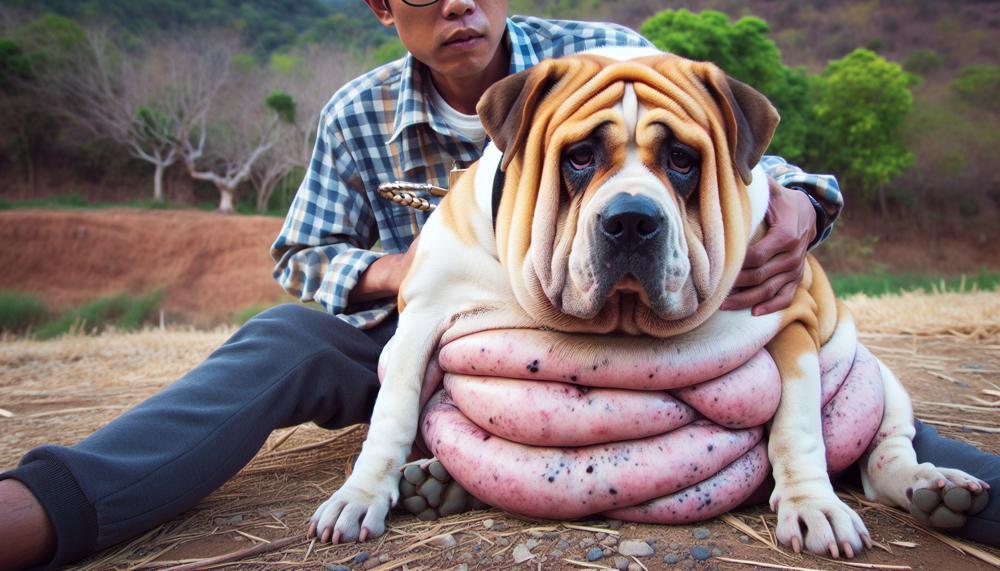We all strive to keep our beloved dogs healthy and happy. But what happens when a seemingly harmless condition like bloat can turn into a life-threatening situation? Bloat, also known as gastric dilatation-volvulus (GDV), is a serious condition that affects dogs. It causes their stomachs to fill with gas, fluid, or food and twist on itself. This can lead to severe complications and even death.
In this blog post, we will delve into the causes and symptoms of bloat in dogs, as well as ways to prevent and treat it. Every dog owner needs to understand bloat risks. These include breed predisposition and diet. You can recognize warning signs, such as a distended abdomen and restlessness. By doing so, you can take preventative measures. This will reduce the chances of your furry friend developing bloat.
But what should you do if your dog does develop bloat? Don’t wait until it’s too late – seek immediate veterinary care. In this article, we’ll give you all the information you need to protect your dog’s health.
Join us as we explore everything you need to know about bloat in dogs. Your furry companion deserves nothing but the best.
How Do Dogs Get Bloat?
Table of Contents
Bloat is a common issue that affects dogs, and it can have various causes. These include eating too quickly, overeating, stress, genetics, and age. However, certain breeds, like those with a large and deep chest, are more susceptible to bloat because of their anatomy.
As a pet owner, there are several measures you can take to prevent bloat in your furry friend.
These include feeding them multiple small meals throughout the day instead of one large meal. Avoid engaging them in physical activities after meals and reducing their stress levels.
In some cases, veterinarians may suggest a preventive gastropexy surgery for high-risk breeds. If your dog does experience bloat, it is crucial to seek prompt medical attention to increase their chances of survival.
Treatment for bloat may involve decompressing the stomach. In severe cases, surgical intervention may be necessary.
The Anatomy and Genetics Behind Bloat
Bloat in dogs develops due to physical and genetic factors. These factors include breed, age, eating habits, genetics, stress, and diet. Larger and giant breeds, as well as older dogs, are more susceptible to bloat due to their specific physical characteristics.
Furthermore, dogs that have a family history of bloat have a greater likelihood of developing this condition.
In addition to these factors, dogs that eat quickly or consume high-fat foods are also at a higher risk for bloat. Certain breeds show a higher prevalence of bloat. This suggests a possible genetic predisposition.
It is crucial to be aware of these contributing factors. Take necessary precautions to reduce the chances of our furry companions developing this potentially life-threatening condition.
Factors That Increase a Dog’s Risk of Bloat
There are various factors that can potentially increase a dog’s risk of developing bloat, such as breed, age, eating habits, genetics, stress, and physical activity. As pet owners, it is crucial to be aware of these factors and take necessary precautions to prevent bloat in our furry friends.
- Firstly, certain breeds are more prone to bloat than others. Large breeds with deep chest cavities, such as Great Danes and Weimaraners, are at a higher risk. Additionally, age can also play a role, with older dogs being more susceptible to bloat due to weakened muscles and decreased mobility.
- Another contributing factor is eating habits. Dogs who consume large meals in one sitting are at a higher risk of developing bloat. To prevent this, it is recommended to feed smaller meals throughout the day rather than one big meal.
- Genetics also play a significant role in a dog’s risk of bloat. If a dog has a family history of bloat, they are more likely to develop it themselves. It is essential to research a dog’s lineage before adopting them and be aware of any potential genetic predispositions.
- Stress and anxiety can also increase a dog’s risk of developing bloat. High-stress situations, such as traveling or being in a new environment, can trigger bloat. As pet owners, it is crucial to manage our dog’s stress levels and provide them with a safe and calm environment.
- Lastly, physical activity after meals can lead to bloat. Strenuous exercise right after eating can cause the stomach to twist and result in bloat. To prevent this, it is recommended to wait at least an hour after meals before engaging in any intense physical activity.
To prevent bloat in our beloved dogs, we must take necessary precautions. This includes feeding smaller meals, avoiding strenuous exercise after meals, providing a high-quality diet, and managing stress levels.
Recognizing the Symptoms of Bloat in Dogs
Bloat, also known as gastric dilatation-volvulus (GDV), is a severe and potentially life-threatening condition. It affects dogs. It occurs when a dog’s stomach becomes filled with air, fluid, or food, causing it to expand and twist. This can result in decreased blood flow and oxygen to vital organs, which can be fatal if not treated.
The symptoms of bloat in dogs include:
- Swollen abdomen: The first indication of bloat is often a visibly enlarged abdomen that may appear bloated or distended.
- Attempted vomiting: Dogs with bloat may try to vomit but are unable to due to the twisted stomach.
- Drooling: Excessive salivation or drooling is a common symptom seen in dogs with bloat.
- Restlessness and anxiety: Dogs with bloat may show signs of restlessness and anxiety, such as pacing or whining.
- Tight abdomen: As the stomach expands, the abdomen can become firm and swollen.
- Inability to vomit: Due to the twisted stomach, bloat prevents dogs from being able to vomit, even when they try.
- Rapid heart rate: A quick heart rate is a sign that a dog’s body is under stress and attempting to compensate for the lack of blood flow.
- Pale gums: Bloat can also cause the gums to become pale due to reduced blood flow.
Pet owners must be familiar with these symptoms and take immediate action if they notice them in their dog. If left untreated, bloat can quickly progress and lead to shock, organ damage, and death. It is crucial to seek veterinary care as soon as possible if you suspect your dog may have bloat.
Preventive Measures to Lower Your Dog’s Risk of Bloat

Preventing bloat in dogs requires taking precautions. You also need to make lifestyle changes. This will decrease the factors that contribute to this condition. You can take several preventive measures as a responsible owner to lower your dog’s risk of developing bloat.
To prevent GDV, monitor your dog’s food intake. Limit exercise before and after meals. Feed multiple small meals instead of one large meal. Avoid elevated food bowls. Be cautious with water intake. Know your dog’s risk factors.
Follow these steps to prevent overeating. Rapidly consuming food and water and other potential bloat triggers can also be prevented using these steps. It is also crucial to seek immediate veterinary care if your dog shows any signs of bloat. Signs include restlessness, excessive salivation, or a swollen abdomen.
By being aware of the risk factors and taking preventive measures, you can help lower your dog’s chances of developing bloat. This will ensure their overall well-being.
Treatment Options for Dogs with Bloat
Bloat, also known as gastric dilatation-volvulus (GDV), is a life-threatening condition. It requires immediate treatment. The severity of the condition will determine the treatment options available. The most effective treatment for bloat is emergency surgery, also known as gastropexy.
This involves untwisting the stomach and securing it in place to prevent future occurrences.
Other treatment options include:
-
- Stabilization with Intravenous Fluids and Oxygen Therapy: The first step in treating bloat is stabilizing the dog’s condition. Intravenous fluids help replenish any lost fluids and electrolytes, while oxygen therapy ensures adequate oxygen supply to vital organs.
- Pain Relief: Bloat can be excruciatingly painful for dogs, and pain relief medications are often administered to alleviate their discomfort.
- Tube or Stomach Pumping: In some cases, a tube may be inserted through the mouth and into the stomach to release excess gas and fluid, relieving pressure on the twisted stomach. A stomach pump may also be used to remove any food or water present in the stomach.
- Airway Protection: To prevent any food or water from entering the lungs during treatment, a veterinarian may protect the dog’s airway by intubating or placing a breathing tube in their throat.
- Conventional Therapies: In cases of shock, dogs may receive IV fluids and corticosteroids, while antibiotics may be prescribed to prevent secondary infections.
In addition to these conventional treatments, there are also some home remedies that may help with a bloated stomach in dogs. These include:
- Probiotics and Prebiotics: Incorporating probiotics or prebiotics into your dog’s diet can help maintain a healthy gut microbiome and aid in digestion, reducing the chances of bloating.
- Dietary Changes: Feeding your dog smaller, more frequent meals and avoiding foods that are known to cause gas can also help prevent bloating.
- Slow Down Fast Eaters: Some dogs are prone to eating too quickly, which can cause them to swallow air and increase their risk of bloating. Using a slow feeder or hand-feeding can help prevent this.
- Massage: Gently massaging your dog’s abdomen can help release gas and alleviate discomfort.
- Light Exercise: Taking your dog for a short walk can also help move gas through their digestive system and relieve bloating.
Conclusion
In conclusion, bloat is a serious and potentially fatal condition. It can affect our beloved canine companions. Responsible pet owners must understand the causes and symptoms of bloat. This helps them prevent and treat it effectively. We can protect our furry friends by being aware of the risks associated with bloat. These include breed predisposition and diet. This way, we can take necessary precautions.
If your dog does experience bloat, immediate veterinary care is crucial. We can provide a calm and stress-free environment for our dogs’ optimal health. This comes from understanding their unique anatomy and needs. Additionally, taking proactive measures can greatly reduce the chances of bloat occurring. For example, eating smaller meals and exercising regularly.
Remember, there are no home remedies for bloat. It is essential to seek professional medical attention if you notice any symptoms in your dog. By staying informed about bloat and taking preventative actions, we can ensure the well-being of our canine companions.






